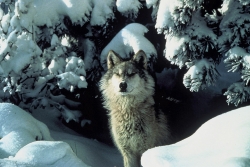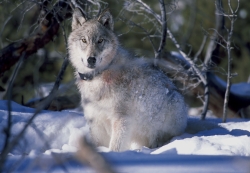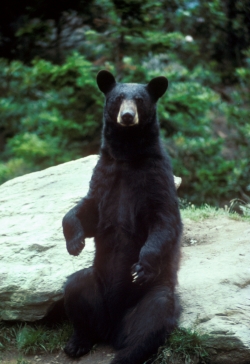
Photo Courtesy US FWS
Tracy Brooks, Photographer
 Yellowstone Gray Wolf(Canis lupus)
Yellowstone Gray Wolf(Canis lupus)
With Radio Collar
Photo Courtesy US FWS
William Campbell, Photographer
Hi, I’m Holly Strand.
In January, a movie called “the Grey” briefly flashed across theater screens. The plot pits man against nature: after a plane crash in the Alaskan wilderness, 7 men struggle to return civilization. In the process, the group is whittled down one by one, victims of ferocious and hungry wolves.
Author Barry Lopez says the wolf as human predator is a theme that runs deep into the human psyche. Thus, this movie is just the latest in a long line of wolf eats man stories. Little Red Riding Hood maybe the most famous example. Aesop’s fables are full of wolves with questionable intentions. The tale that chills me the most is a flashback within Willa Cather’s My Ántonia. Riding sleds in a snowstorm, an entire wedding party is attacked and then devoured by a pack of hungry wolves, the bride screaming in terror until she is taken down and finished off….. Ugh.
On the other hand we have legends and accounts that praise the wolf as noble and even familial. Many native American groups revered the wolf for its strength and survival skills.
The founders of Rome, Romulus and Remus were supposedly raised by wolves, as was Mowgli in Rudyard Kipling’s Jungle Book. In 1963 Farley Mowat published Never Cry Wolf, which led many people to see wolves in a more sympathetic light.
So how do wolves regard humans? Are we a creature to be avoided or are we dinner entrees?
Not long ago, a team of researchers examined the data on wolf attacks from a handful of European countries plus North America. From these records they drew the following conclusions:
- The majority of attacks on humans involve wolves with rabies.
- Among non-rabid attacks, most victims were children, and to a lesser extent, adult women.
- When wolves lose their fear of humans, attacks increase dramatically.
- Wolf–dog hybrids are innately less fearful of humans, making them extremely dangerous.
- And lastly—and not surprisingly—provoking a wolf is likely to incite an attack. Cornering a wolf or entering a den with pups is not a good idea.
The study also confirmed that the number of attacks on humans has dropped dramatically in the last century. This is not just because there are fewer wolves. It’s that the situations leading to attacks are not common anymore:
For instance, the incidence of rabies has dropped dramatically in North America and Europe.
And we no longer send our children out alone to tend sheep or other livestock, an invitation for a wolf attack.
Another factor is that legislation has curtailed the breeding of wolf-dog hybrids. Now 40 U.S. states effectively forbid the ownership, breeding and importation of wolf-dogs, while others impose some form of regulation upon ownership.
In summary, the consensus of wolf specialists is that under normal circumstances people aren’t on the wolf’s menu. Bears, cougars, tigers and other large carnivores are more likely to attack humans.
For Wild About Utah, I’m Holly Strand.
Credits:
Images: Courtesy US FWS https://images.fws.gov
Text: Holly Strand
Sources & Additional Reading:
Carnahan, Joe. Director. 2012. The Grey https://www.imdb.com/title/tt1601913/
Linnell, J.D.C., R. Andersen, Z. Andersone, L. Balciauskas, J.C. Blanco, L. Biotani, S. Brainerd, U. Breitenmoser, I. Kojola, O. Liberg, J. Loe, H. Okarma, H. Pedersen, C. Promberger, H. Sand, E. Solberg, H. Valdmann, P. Wabakken. 2002. The fear of wolves: A review of wolfs attacks on humans. NINA Oppdragsmelding: 731:1-65. https://www.lcie.org/docs/damage%20prevention/linnell%20nina%20op%20731%20fear%20of%20wolves%20eng.pdf
Löe J. and E. Röskaft. 2004. Large Carnivores and Human Safety: A Review. AMBIO: A Journal of the Human Environment Aug 2004 : Vol. 33, Issue 6, pg(s) 283-288
Lopez, Barry. 2004. Of Wolves and Men. Twenty-fifth anniversary edition, Scribner.
Mech, L. David. 1991. The way of the wolf. Voyageur Press, Stillwater, MN
Palamar, Colette. A History of Attitudes Toward Wolves. University of Idaho.
https://www.class.uidaho.edu/kpgeorge/issues/wolves_history/history_symbol.htm [accessed April 18, 2012]
Silver, Marc. 2012. Would Real Wolves Act Like the Wolves of ‘The Grey’? National Geographic interview of Daniel MacNulty, Utah State University. [accessed April 18, 2012]





